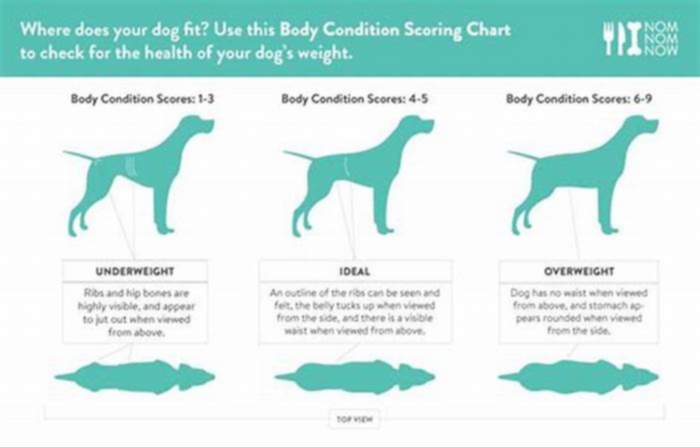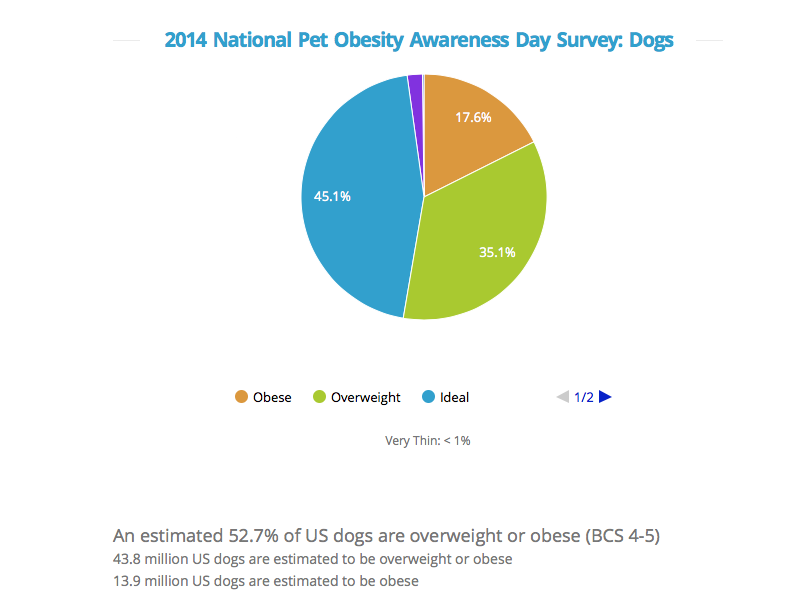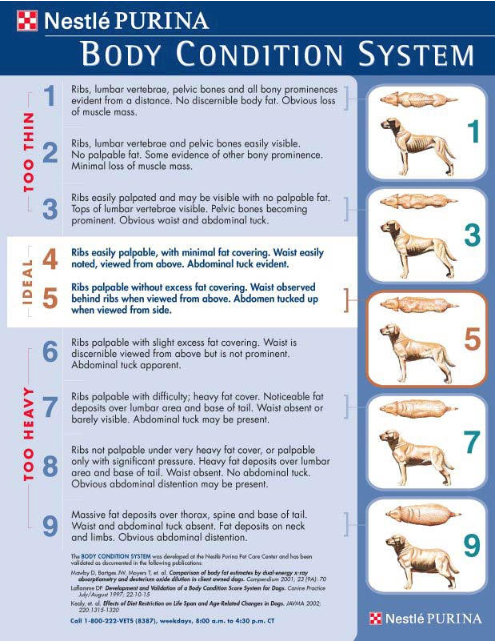How do I tell if my dog is too fat

Dog Obesity: Why Its Important To Manage Your Dogs Weight
Plump puppies may be cute, but when it comes to canine health, lean is better.
Still, as is true with humans, too many dogs are overweight, according to the Association For Pet Obesity Prevention (APOP). In its eighth annual survey of the girth of American pets, released in March 2015, the organization found that 53 percent of the nations dogs are overweight.
International research suggests that this is a global problem, with surveys from various parts of the world showing that the incidence of canine obesity around 40 percent or more.Most investigators say that this health issue gets worse each year. Another part of the APOP survey showed that in 2014, 17.6 percent of dogs were clinically obese (30 percent or more overweight). That was up a full point from just one year before.


Courtesy of APOP
Even worse, 95 percent of owners dont realize that their plump dogs need to drop a few pounds. The APOP calls this a fat pet gap, in which a chubby dog is identified as normal.
Dr. Ernie Ward, veterinarian and founder of APOP says, Pet owners think their obese dog or cat is a normal weight, making confronting obesity difficult. No one wants to think their pet is overweight, and overcoming denial is our first battle.
Health Problems Caused By Dog Obesity
There are many diseases and conditions that come along with extra pounds. These include:
How to Tell If Your Dog Is Obese
The rules range for people, but for pets, figuring out whether your dog is overweight or obese is a matter of both appearance and touch. You should, for example, be able to feel your dogs ribs when you press her sides. Several dog-food manufacturers have canine body-condition charts that can help you determine if your dog needs to drop a few pounds. Heres an example:


What to Do If Your Dog Needs a Diet?
As with humans, there are a few tried-and-true methods for slimming down. First, you should check with your vet to make sure that the excess weight is not the result of an underlying health problem or disease. Also, before you changefood or reduce calories, youll want to get your dog a checkup and talk to your vet about the best options. After taking these steps, check out these helpful tips:
Measure Meals:Keeping a diary is one of the most important steps in any human weight-loss program. Since dogs cant write, youll have to do it for him. Keep track of how much kibble you are feeding by using a measuring cup.
Establish a Schedule:If you free-feed, leaving food down all day, offer meals on a set schedule. Put the food down for a certain time, perhaps 15 minutes, and take up any food that the dog does not eat.
Limit Between-Meal Snacks:Dogs get a lot of calories in addition to their regular kibble. These can include anything from training treats to a biscuit slipped over the fence by a friendly neighbor. Those calories add up. Find out where the extras are coming from and manage how many extra goodies the dog is getting.
Choose Low-Calorie Treats:Many store-bought treats, especially biscuits, can be fattening. The same goes for chews. Some dogs will be just as happy with fruits or vegetables, like bananas, carrots, green beans, and apple slices, for example.
Certain chews, such as the popular bully sticks, are higher in calories than most people believe. A recent study from Cummings School of Veterinary Medicine at Tufts University examined the nutrients found in 26 different kinds of bully sticks. Each inch contained between 9 and 26 calories. While calorie information isnt currently required on pet treats or most pet foods, these findings reinforce that veterinarians and pet owners need to be aware of pet treats like these bully sticks as a source of calories in a dogs diet, Lisa M. Freeman, DVM, Ph.D., DACVN, professor of nutrition at TCSVM, said in a news release describing the study results. Several companies have developed low-calorie commercial treats. When you try any new treat, offer just a small portion to make sure it agrees with your dogs digestion.
Get Moving! This may be the best thing you can do to help your heavy hound. Before starting any exercise regime, have your dog checked by your veterinarian to make sure it is an appropriate and reasonable activity. Start slow and work up as directed by your vet to prevent possible injury.There are so many activities you and your dog can do together that its impossible to mention them all. Here are some of the best to start a weight-reducing program:
- Swimming is low-impact and can build muscles and burn calories without hurting joints.
- Walking, also low-impact, has the added benefit of getting both of you out of the house and into the fresh air.
- Fetch is fun, and its quick sprints will do a lot to raise fitness levels.
Do I Have A Fat Dog? How To Tell If Your Dog Is Overweight
Theres no doubt about it - Americans love their dogs! We know that your pooch is the best breed, but have you wondered which are the most favored dog breeds in America? Forbes surveyed 10,000 dog owners across the 50 states to find Americas top dog breed. The survey involved the top 25 most popular dog breeds nationwide, according to the American Kennel Club. So, what is Americas top dog? As it turns out, no breed in particular is the countrys favorite at 13%.However, if Americans had to decide, theyd pick the Australian shepherd as a favorite, followed by the German shepherd and the bulldog.The highly intelligent and energetic Australian shepherd was ranked as the top dog breed in 10 states, including Alabama, Arizona, Alaska, Arkansas, Georgia, Indiana, Montana, Missouri, New York, and Virginia. This breed was also voted the second favorite in nine states. Although Aussies won the popularity vote, the German shepherd was the number one pick in 16 states. Thats more than any other breed!Known for its loyal and courageous nature, the German shepherd is the most common breed to serve as a police K9 but also makes a wonderful family companion. They ranked as the second favorite dog breed in nine states. Interestingly, more men than women picked German shepherds as their favorite breed (9% compared to 6%). Americas 3rd favorite breed, according to Forbes, is the bulldog. The English bulldog is a medium-sized dog breed, best known for its stocky build, large head, and wrinkled face. The bulldog ranked as the top dog in eight states, including Illinois, Connecticut, Missouri, Mississippi, North Carolina, South Carolina, West Virginia, and Utah. Among all states, Nebraska ranked the bulldog lowest, placing this breed at 24th place, The lovable and friendly Labrador retriever ranked as the nations 4th favorite breed. Thanks to their affectionate, friendly, and energetic nature, Labs make great companions to people of all ages and families with children. Labrador retrievers ranked as the most favorite dog breed in 10 states, including Louisiana, Idaho, Minnesota, Montana, Massachusetts, Nebraska, New Hampshire, Oregon, South Dakota, and West Virginia. Bernese mountain dog is the 5th favorite dog breed in the United States. Large in size and built for hard work, Bernese mountain dogs are easy to train and make affectionate, loyal, and faithful companions. So, its no surprise that this doggo ranked as the most favorite breed in nine states. Compared to four other top-ranked breeds, the Bernese mountain dog had the most varying results, with 10 states ranking this breed in the bottom 10.The beagle is the nations favorite small breed. Ranked as the 6th favorite breed overall, the beagle was placed in the top 10 favorite breeds in all but seven states. This breed received the lowest ranking in Utah, where it was voted as the states 3rd least favorite breed.The golden retriever comes in at 7th place, after being voted as the most favorite dog breed in Michigan and Wisconsin. Medium in size and best known for their gorgeous golden coats, golden retrievers are loving, loyal, and affectionate companions to active people and families with children. Goldens were the 2nd favorite dog breed in four states, including New Hampshire, North Dakota, Connecticut, and Vermont. This breed ranked the lowest in Alabama, where it received 17th place.These are Americas most favorite dog breeds, but the nation also has the least favorite doggo. This title goes to the Havanese, which was the bottom-ranked breed in 33 states.The Havanese is followed by Pembroke Welsh Corgi which was the least favorite dog breed in 17 states. And what about you? Whats your favorite and least favorite dog breed?Join the PetGuide community. Get the latest pet news and product recommendations by subscribing to our newsletter here.
How Can You Tell If Your Pet Is Overweight?
Reviewed for accuracy and updated on November 5, 2019, by Dr. Katie Grzyb, DVM
According to the Association for Pet Obesity Preventions (APOP) 2018 Pet Obesity Survey, 55.8% of dogs are classified as overweight or obese.
That means that most pets these days are overweight, even if many of their owners dont realize it.
But dog owners should be paying more attention to their dogs weight, since being overweight puts your dog at risk for many diseases, including diabetes, cardiovascular disease andarthritis.
And while your vet can diagnose an overweight or obese dog, its easy for you to determine, too, if you know how.
Here are some tips for how to tell if your dog is overweight so that you can start a conversation with your veterinarian and help get your dog back to a healthy weight.
How to Determine If Your Dog Is Overweight
Here are three of the most reliable tools for determining if your dog is overweight.
Body Condition Score Charts
The best way to determine whether a pet is obese is by using a measurement system such as the body condition score, says Dr. Jim Dobies, a veterinarian with South Point Pet Hospital in Charlotte, North Carolina, and a member of the North Carolina Veterinary Medical Association (NCVMA).
Body condition score charts help you figure out where your pet falls on the healthy weight scale. Most body condition score charts work on a scale of 1-5 or 1-91 being emaciated, and the highest number being morbidly obese.
The World Small Animal Veterinary Association (WSAVA) has a great example of a body condition score chart that depicts the side view and top view of dogs that are emaciated, underweight, average, overweight and obese.
Visually Assess Your Dogs Body
But you can also assess your dog without using a dog body condition chart, Dr. Dobies says.
The best way to visually assess your dogs weight is to stand above them and look down on them. You should be able to feel their ribs but not see them. If you can see them, they are too skinny, Dr. Dobies explains.
If you cant see your dogs ribs, and you cant feel them by placing your hands on the sides of their chest, your dog is overweight, says Dr. Dobies.
Dogs should also have a nice taper at their waist (between the abdomen and where the hips go into the socket), he says. If there is very little or none at all, they are too heavy and theyll be oval-shaped.
And a very obese dog, he says, will have a pendulous abdomen, hip fat and neck fat, all of which are very noticeable. But pets dont usually reach this point of obesity until theyre at least 7 years old, he adds.
Healthy Weight Protocol for Dogs
Veterinarians can also use tools like the science-based Healthy Weight Protocol, which was created by Hills Pet Nutrition in conjunction with veterinary nutritionists at the University of Tennessee.
A vet takes measurementsfour for a dogthen inputs them into the Healthy Weight Protocol system to determine your dogs body fatindex. By comparing this with a chart, your veterinarian can tell you exactly how much weight your pet needs to lose if they are overweight.
This system allows vets to take a more scientific approach to a dogs weight loss needs. It helps them to determine exactly how many pounds a dog would need to lose and how many calories a day they need to do that healthily.
Talk With Your Veterinarian
Your veterinarian is your greatest ally for maximizing your dogs overall health. They can help you determine whether your dog is currently overweight and help you devise the best plan for helping your dog shed the extra weight in a safe way.
By: Amanda Baltazar
Featured Image: iStock.com/Firn
